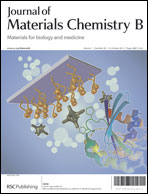Biomimetic and molecular level-based silicate bioactive glass–gelatin hybrid implants for loading-bearing bone fixation and repair†
Abstract
Biomedical implants for successful bone fixation and repair should be biodegradable, and of matched mechanical strength, bone-bonding bioactivity and good biocompatibility. However, current bone implants in the clinic and research are usually not meeting the demands of ideal implants. Here, at low temperatures, we develop a biomimetic molecular level-based silicate bioactive glass–gelatin bone implant with matched physicochemical and biological properties. Our implant could mimic the physical structure at the molecular and nanoscale levels, and presents a high compressive strength (beyond 120 MPa), suitable modulus (300–600 MPa) and strain percent (30%). In addition, the biomimetic implants also showed a linear biodegradation behavior which indicated their stable biodegradation ability. An in vitro simulated body fluid (SBF) test showed that a uniform biomineralization layer was formed on the implant under short times, which shows the good bone-bonding bioactivity of the implants. An in vitro marrow stem cells (MSC) culture showed that our biomimetic implants possessed good biocompatibility by enhancing cell proliferation. These results indicated that our biomimetic hybrid implants may be competitive candidates for bone fixation and repair biomaterials.


 Please wait while we load your content...
Please wait while we load your content...